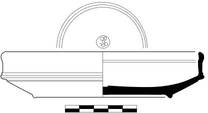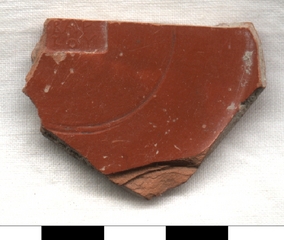Greek, Roman and Byzantine Pottery at Ilion (Troia):
Sebastian Heath and Billur Tekkök, Editors
Eastern Sigillata B
Please note that this is a public draft of work in progress
Eastern Sigillata B is a Roman period fine tableware manufactured at workshops in or near Tralles in western Asia Minor. Its early forms show Italian influence and at least two early workshops may have been established by potters coming from the west . Though always less common than the ESC/Candarli, which was made in closer workshops, ESB is a regular feature in first and early second century AD deposits. The ware is recognizable by its thick "soapy" slip and highly micaceous fabric, both of which attributes are more pronounced in later vessels. Occasionally, ESB is fired black, with one such example listed below.
1. Eastern Sigillata Bi Footed Bowl Base (late 1st Century BC - early 1st Century AD)
P. H. .016. Est. diam. base .10 (<1/4 preserved). Th. .0035.
K/L16/17.0430:1. Complete base. Fine orange brown (2.5YR 6/8) fabric with tiny golden mica. Interior is covered with thick and very smooth orange (2.5YR 4/8) slip, thinner on exterior; underside of foot is plain. There is excess clay and surface voids on underside of base.
Cf. , nos. H73-83.
svg/K-L16-17.0430-1.jpg
2. Eastern Sigillata Bi Hayes Form 4 Rim (early 1st)
P. H. .024. Est. diam. rim .18.
K/L16/17.0427:5. Single rim sherd. Micaceous orange-brown (2.5YR 4/6) fabric, red (2.5YR 4/8) slip. Light rouletting under rim.
, tavola xi.13.
svg/K-L16-17.0427-5.jpg
3. Eastern Sigillata Bi Hayes Form 12 Rim (AD 50-75)
H. .026. Est. diam. rim .016 (<1/10 preserved). Th. .0047.
z06.0025:1. Single rim sherd. Downturned rim. Rouletting on outer face of rim.
, tavola XII.3. Shares characteristics with , no. H22.
z06.0025-1.jpg
4. Eastern Sigillata Bi Plate near Hayes Form 14 Rim (AD 50-100)
Th. .007.
z07.0052:3. Single rim sherd. Too small to recover diameter, stance provisional. High rim with external carination at meeting of floor and rim, two narrow grooves below interior rim.
Cf. , tavola XII.6; also , nos. 62 and 63; , no. H1. None of these have as sharp an external carination nor interior grooves.
z07.0052-3.jpg
5. Eastern Sigillata Bi Hayes Form 22 Rim (Augustan)
H. .026. Th. .004.
z07.0029:1. Single rim sherd. Fine red (2.5YR 5/8) fabric with some mica. Slightly darker (2.5YR 6/8), thick and smoothed slip. Everted rim, upturned at outer edge.
, p. 57, tavola XII.16-17. , no. 36, , no. H95.
z07.0029-1.jpg
6. Eastern Sigillata Bi Hayes Form 35 (mid 1st century AD)
H. .038. Est. diam. rim .086 (1/10 preserved). Th. .004.
K/L16/17.0120:5. Single sherd. Micaceous, very fine, brown (2.5YR 6/8) fabric. Flaking deep brown (2.5YR 4/8) slip on all surfaces, thicker under short rim.
, p. 60, tavola XIII.5.
svg/K-L16-17.0120-5.jpg
7. Eastern Sigillata Bi Hayes Form 40 Beaker Base (early first AD)
P. H. .017. Est. diam. base .07 (1/3 preserved). Th. .0027.
K17.0845:8. Single sherd, lower wall and floor. Micaceous brown (5YR 6/6) fabric, thick red (2.5YR 4/8) slip. Concentric grooves on underside and a single groove on lower exterior wall.
Cf. , p. 61, tavola XIII.12.
svg/K17.0845-8.jpg
8. Eastern Sigillata Bii Hayes Form 58 Profile (AD 50-125)
H. .031. Est. diam. rim .139. Est. diam. base .11.
. P0419. Almost complete. Soft fabric with shiny orangish slip, in some parts whitish (water irritation). Plate with low base and vertical rim. Double incision inside the rim; triple incised groove on the outside just above the base; central stamp with seven-petalled rosette in an indented circle; rouletting around the rim barely visible. From the Hadrianic deposits of the C29 well.
First published as no. 25. , p. 63, tavola 14.3.
svg/P0419.jpg
9. Eastern Sigillata Bii Hayes Form 58 Profile (AD 50-125)
H. .025. Est. diam. rim .12 (1/10 preserved). Th. .005.
D20.0093:2. Single rim sherd preserves profile. Soft, brown (2.5YR 6/8) fabric with frequent tiny mica. Slightly darker red slip (near 2.5YR 5/8) on exterior. Incised interior circle around base.
, p. 63, tavola 14.3.
D20.0093-2.jpg
10. Eastern Sigillata Bii Hayes Form 58 (AD 50-125)
H. .025. Est. diam. rim .14 (1/10 preserved). Th. .0043.
K17.0860:59. Single rim sherd. Soft, brown (5YR 6/6) fabric with frequent tiny mica. Flaking, red slip (near 10R 4/8) . Single incised line under rim.
, p. 63, tavola 14.3.
K17.0860-59.jpg
11. Eastern Sigillata Bii Hayes Form 58 (AD 50-125)
H. .026. Est. diam. rim .145 (1/8 preserved). Th. .0068.
K17.0860:60. Single rim sherd. Soft, reddish brown (2.5YR 6/8) fabric with frequent tiny mica. The thick darker slip (2.5YR 6/8) is flaking off.
, p. 63, tavola 14.3.
K17.0860-60.jpg
12. Eastern Sigillata Bii Hayes Form 58 Rim (50 to 125 AD)
P. H. .017.
K/L16/17.0474:5. Single rim sherd with part of floor. Compact brown (2.5YR 6/8) fabric with frequent golden mica. Dark red (2.5YR 4/8), flaking slip on all surfaces.
, p. 63, tavola XIV.
svg/K-L16-17.0474-5.jpg
13. Eastern Sigillata Bii Type 58 Base (AD 50 to 125)
P. H. .015. Est. diam. base .095 (1/5 preserved). Th. .0036.
K/L16/17.0427:2. Single base sherd. Micaceous orange-brown (2.5YR 4/6) fabric, red (2.5YR 4/8) slip is worn. Two incised grooves.
svg/K-L16-17.0427-2.jpg
14. Eastern Sigillata Bii Type 58 Base, fired black (AD 50 to 125)
P. H. .011. Est. diam. base .11 (1/5 preserved). Th. .0038.
K/L16/17.0100:26. Greenish gray (10YR 6/3) fabric with frequent mica. Thick polished black slip on all extant surfaces. Light groove outside of base on exterior.
svg/K-L16-17.0100-26.jpg
15. Eastern Sigillata Bii Hayes Form 60b (100-150)
H. .032. Est. diam. rim .17 (1/10 preserved). Th. .004.
H17.0727:1. Single sherd preserves rim and wall to base. Soft, reddish brown (2.5YR 6/8) fabric with frequent tiny mica. Darker (2.5YR 5/8), thick slip on all preserved surfaces.
, p. 63, tavola 14.5-6. Cf. , no. 90 for date.
H17.0727-1.jpg
16. Eastern Sigillata Bii Hayes Form 60b (100-150)
H. .042. Est. diam. rim .20 (1/10 preserved). Th. .0055.
K17.0860:49. Single rim sherd. Soft, reddish brown (2.5YR 5/6) fabric with frequent tiny mica. Lighter (2.5YR 5/8) slip on all preserved surfaces.
, p. 63, tavola 14.7. Cf. , no. 89a for date.
K17.0860-49.jpg
17. Eastern Sigillata Bii Hayes Form 61, fired black (AD 50-100)
H. .025. Est. diam. rim .20 (1/10 preserved). Th. .0035.
z08.0418:3. Two joining sherds preserve rim and part of floor. Gray () fabric with frequent mica. Dark gray, lustrous slip on all surfaces.
, form 61. Same profile at no. 78 (in red).
z08.0418-3.jpg
18. Eastern Sigillata Bii Hayes Form 66 Rim
Est. diam. rim .13.
C29.0473:1. Fabric was originally orange but now white; it had been burned or exposed to water.
First published as no. 31. , form 66, plate 14.17.
C29.0473-1.jpg
19. Eastern Sigillata Bii Hayes Form 73 Profile
H. .034. Est. diam. rim .081 (1/2 preserved). Est. diam. base .042.
. P0546. Upright rim has shallow grooves inside, a shallow groove outside just above the base, and a deep groove where the base stanfs. Thick, flaking bright orange slip. From the Hadrianic fill of the C29 well.
First published as no. 32. , form 73, plate 15.5.
svg/P0546.jpg
20. Eastern Sigillata Bii Hayes Form 76 variant (100-150 AD)
H. .042. Est. diam. rim .030 (<1/20 preserved). Th. .0063.
K/L16/17.0427:1. Two joining sherds sherd preserving complete profile. Micaceous orange-brown (2.5YR 4/6) fabric, red (2.5YR 4/8) slip. The distinctive features of the vessel are the ESB 76-type “hollow” base and the everted rim with rounded top that has two closely spaced grooves at its midpoint. The rim is also distinguished from the interior wall by a shallow offset. Likewise the floor and inner wall are separated by a groove. In general, the rim of this vessel suggests a large 55, whereas the base is good for a 76. An intermediate form would belong to the early 2nd century.
Cf. , p. 68-69; tavola XV.11.
svg/K-L16-17.0427-1.jpg
21. Eastern Sigillata Bii Hayes Form 76 (100-150 AD)
H. .02. Est. diam. rim .024 (1/10 preserved). Th. .007.
K/L16/17.0467:7. Brown micaceous fabric (5YR 6/6), orange slip (10R 5/8) flaking in places and thickly applied under rim.
, p. 68-69; tavola XV.11.
svg/K-L16-17.0467-7.jpg
22. Eastern Sigillata B Bowl Base
z06.0007:32. SC09-1i. Single base sherd. Stamped floor.
General Bibliography
Coldstream, John, L. Eiring
and G. Forster. 2001.
Knossos Pottery Handbook. Greek and Roman British School at Athens Studies 7. London.
[
worldcat.org]
Hayes, John. 1985.
“Sigillate Orientali” in
Enciclopedia dell'arte antica classica e orientale. Atlante delle Forme Ceramiche II, Ceramica Fine Romana nel Bacino Mediterraneo (Tardo Ellenismo e Primo Impero), Rome: 1-96.
Lund, John. 2003.
“Eastern Sigillata B: a ceramic fine ware industry in the political and commercial landscape of the Eastern Mediterranean” in
Catherine Abadie-Reynal (ed.), Les Ceramique en Anatolie aux Epoques Hellenistique et Romaine, Paris: 125-136.
Malamidou, Vaitsa. 2005.
Roman Pottery in Context: Fine and Coarse wares from five sites in north-eastern Greece British Archaeological Reports International Series 1386. Oxford.
[
worldcat.org]
Wrabetz, James. 1977.
“A new Serenus stamping from Sardis and the origins of the Eastern Sigillata B ware,”
Harvard Studies in Classical Philology 81: 195-197.
[
online]
Related Resources for Catalog
These links provide well-known identifiers for concepts appearing in this catalog.





















